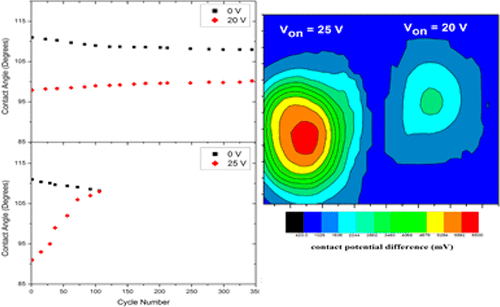当前位置:
X-MOL 学术
›
ACS Appl. Mater. Interfaces
›
论文详情
Our official English website, www.x-mol.net, welcomes your feedback! (Note: you will need to create a separate account there.)
Performance and Reliability of Electrowetting-on-Dielectric (EWOD) Systems Based on Tantalum Oxide
ACS Applied Materials & Interfaces ( IF 9.5 ) Pub Date : 2017-11-17 00:00:00 , DOI: 10.1021/acsami.7b07366 Marcel Mibus 1 , Giovanni Zangari 1
ACS Applied Materials & Interfaces ( IF 9.5 ) Pub Date : 2017-11-17 00:00:00 , DOI: 10.1021/acsami.7b07366 Marcel Mibus 1 , Giovanni Zangari 1
Affiliation

|
The electrowetting-on-dielectric behavior of Cytop/Tantalum oxide (TaOx) bilayers is studied by measuring their response vs applied voltage and under prolonged periodic cycling, below and above the threshold voltage VT corresponding to the breakdown field for the oxide. TaOx exhibits symmetric solid state I–V characteristics, with electronic conduction dominated by Schottky, Poole–Frenkel emission; conduction is attributed to oxygen vacancies (6 × 1016 cm–3), resulting in large currents at low bias. Electrolyte/Metal Oxide/Metal I–V characteristics show oxide degradation at (<5 V) cathodic bias; anodic bias in contrast results in stable characteristics until reaching the anodization voltage, where the oxide thickens, leading eventually to breakdown and oxygen production at the electrode. Electrowetting angle vs applied voltage undergoes three different stages: a parabolic variation of contact angle (CA) with applied voltage, CA saturation, and rebound of the CA to higher values due to degradation of the polymer layer. The contact angle remained stable for several hundred cycles if the applied voltage was less than VT; degradation in contrast is fast when the voltage is above VT. Degradation of the electrowetting response with time is linked to charge accumulation in the polymer, which inhibits the rebound of the CA when voltage is being applied.
中文翻译:

基于氧化钽的电介质上电润湿(EWOD)系统的性能和可靠性
通过测量Cytop /钽氧化物(TaOx)双层的响应与施加电压之间的关系以及在延长的周期性循环下,低于和高于对应于该氧化物击穿场的阈值电压V T的情况下,研究了其在电介质上的电润湿性能。TaOx表现出对称的固态I – V特性,其电子传导主要由肖特基,普尔-弗伦克尔发射引起;传导归因于氧空位(6×10 16 cm –3),从而在低偏压下产生大电流。电解质/金属氧化物/金属I – V特性显示在(<5 V)阴极偏压下氧化物降解;相反,阳极偏压会导致特性稳定,直到达到阳极氧化电压为止,在该电压处氧化物会变厚,最终导致击穿和电极上的氧气产生。电润湿角与施加电压的关系经历了三个不同的阶段:接触角(CA)与施加电压的抛物线变化,CA饱和以及由于聚合物层的降解而使CA回弹到更高的值。如果施加的电压小于V T,接触角在几百个周期内保持稳定; 当电压高于V T时,对比度下降很快。电润湿响应随时间的下降与聚合物中电荷的积累有关,这会在施加电压时抑制CA的反弹。
更新日期:2017-11-19
中文翻译:

基于氧化钽的电介质上电润湿(EWOD)系统的性能和可靠性
通过测量Cytop /钽氧化物(TaOx)双层的响应与施加电压之间的关系以及在延长的周期性循环下,低于和高于对应于该氧化物击穿场的阈值电压V T的情况下,研究了其在电介质上的电润湿性能。TaOx表现出对称的固态I – V特性,其电子传导主要由肖特基,普尔-弗伦克尔发射引起;传导归因于氧空位(6×10 16 cm –3),从而在低偏压下产生大电流。电解质/金属氧化物/金属I – V特性显示在(<5 V)阴极偏压下氧化物降解;相反,阳极偏压会导致特性稳定,直到达到阳极氧化电压为止,在该电压处氧化物会变厚,最终导致击穿和电极上的氧气产生。电润湿角与施加电压的关系经历了三个不同的阶段:接触角(CA)与施加电压的抛物线变化,CA饱和以及由于聚合物层的降解而使CA回弹到更高的值。如果施加的电压小于V T,接触角在几百个周期内保持稳定; 当电压高于V T时,对比度下降很快。电润湿响应随时间的下降与聚合物中电荷的积累有关,这会在施加电压时抑制CA的反弹。



























 京公网安备 11010802027423号
京公网安备 11010802027423号